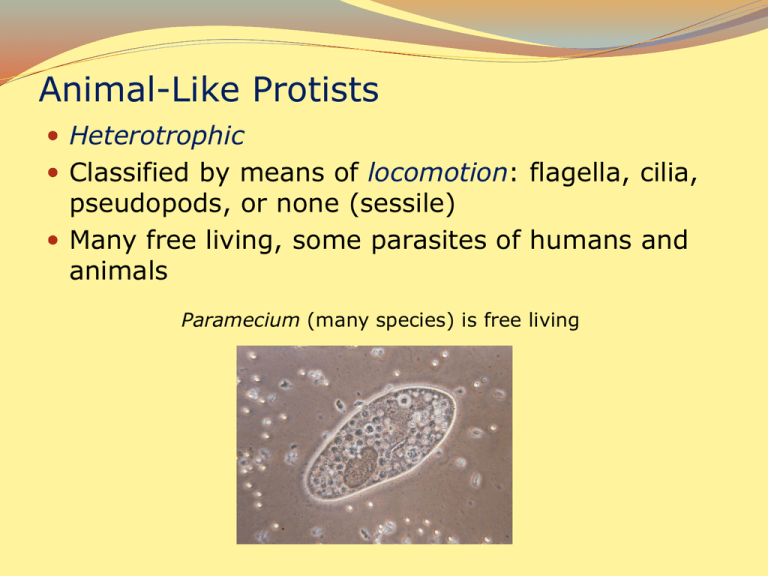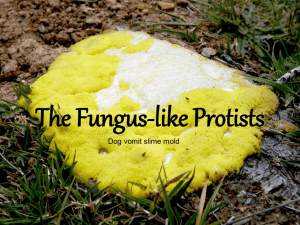protists_-_heterotrophic
advertisement

Animal-Like Protists Heterotrophic Classified by means of locomotion: flagella, cilia, pseudopods, or none (sessile) Many free living, some parasites of humans and animals Paramecium (many species) is free living Animal-Like Protists Phylum Protozoa Locomotion by pseudopodia cytoplasmic streaming/cyclosis amoeboid movement Prey on bacteria, ingest food particles in water using pseudopodia vesicle, intracellular digestion Subphylum Sarcodina - amoebas: freshwater, marine or soil; some have a test/shell around cell membrane Subphylum Mycetozoa – some have glassy shells (radiolarians) Testate Amoebas Simple tests (or shells) are made by either secretion or by the agglutination of foreign material or a combination of both. Environmental changes can be determined by analyzing the composition of tests, including fossil tests, which may indicate past climatic conditions. Radiolarian (marine amoeba) shells Animal-Like Protists Phylum Ciliophora Locomotion by cilia Asexual reproduction – binary fission Most elaborate organelles of any protist: Macronucleus that controls cell functions Micronucleus exchanged through conjugation (sexual reproduction) pellicle (elastic layer of protein) surrouding cell membrane Food acquisition: oral groove mouth pore gullet food vacuoles Excretion: anal pore contractile vacuole Animal-Like Protists Phylum Sarcomastigophora Trypanosomes in human blood Tsetse fly (vector) One or more flagella Subphylum Mastigophora – many free living, some parasites genus Trypanosoma Infect blood in many vertebrates Transmitted by insect vectors Ex.: African sleeping sickness, caused by two species of trypanosomes, transmitted by tse-tse fly fever, lethargy, eventual coma, death; Giardia – found in fresh water gastrointestinal disease Giardia lamblia causes giardiasis, an intestinal infection Found in freshwater – streams & rivers Cysts carried in animal feces Animal-Like Protists Phylum Apicomplexa (former sporozoans) Plasmodium faciparum no adaptations for locomotion all animal parasites Apical complex = organelles specialized for entry into host cells/tissues Complex life cyles with sexual and asexual stages, often more than one host Plasmodium – mosquito vector malaria Toxoplasma gondii – affects developing fetuses, newborns Cryptosporidium – found in water, animal feces gastrointestinal disease Anopheles mosquito vector Malaria life cycle on UTube Malaria 350–500 million cases / year, killing one to three million people Fungus-Like Protists Slime Molds & Water Molds Uni- or multi-cellular, all heterotrophic Saprophytic, some parasitic Fungus-Like Protists Phylum Myxomycota – Plasmodial Slime Molds Feeding stage = Plasmodium, a multinucleated (2n) mass of cytoplasm Amoeboid movement by cytoplasmic streaming phagocytosis of decaying matter Reproductive state = Fruiting bodies produce haploid spores by meiosis Spores produce haploid (n) reproductive cells that fuse (2n) mitosis w/o cytokinesis multinucleated plasmodium (unicellular) Physarum life cycle Fungus-Like Protists Phylum Dictyostelida – Cellular Slime Molds Individual haploid cells live independently Scarcity of food triggers release of chemical that attract others Many cells gather to form a multi-cellular pseudoplasmodium – (each cell retains its membrane) develops fruiting bodies haploid spores new independent haploid cells How do cellular slime molds differ from plasmodial slime molds? Fungus-Like Protists Phylum Oomycota – Water Molds Asexual reproduction -- flagellated zoospores threadlike cells Sexual reproduction – egg and sperm produced fertilization tubes zygote threadlike cells Water mold on dead mayfly larva Fungus-Like Protists Phylum Chytridiomycota – Water Molds Healthy Tasmanian frog Most unicellular, parasitic Make flagellated gametes and zoospores Chitin in cell walls, filamentous cells, enzymes and biochemistry similar to fungi some classify them in kingdom Fungi may be a transitional form between protists and fungi Infected frog Chytrid (microscopic)






